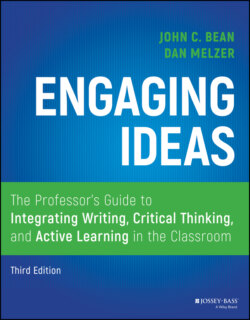Читать книгу Engaging Ideas - John C. Bean - Страница 54
“And Then” Writing, or Chronological Structure
ОглавлениеBy “and then” writing we mean a chronological narrative in which the writer tells what happens between time point A and time point B without focus, selection, pacing, or tension. Students produce “and then” writing when they resort inappropriately to chronological organization. Typical examples are students' writing a plot summary of a film or short story instead of an analysis. Another example, commonly encountered in the sciences, is students' writing a literature review that simply summarizes articles in chronological order by date of publication rather than analyzing what's known and unknown.
“And then” writing can be illustrated by the following student's difficulty in producing an interpretive argument about Shakespeare's The Tempest. This excerpt is from the introduction of the student's first draft:
Prospero cares deeply for his daughter. In the middle of the play Prospero acts like a gruff father and makes Ferdinand carry logs in order to test his love for Miranda and Miranda's love for him. He is also very cruel to the servant Caliban. In the end, though, Prospero is a loving father who rejoices in his daughter's marriage to a good man.
Here the student seems to be summarizing the plot of The Tempest without forecasting an argument or proposing a thesis. The body of this draft contained similar passages of lengthy plot summary. However, in an office conference the instructor discovered that the student actually intended an argument. She thought that Prospero was a loving father, in contrast to several of her classmates who thought that Prospero was a tyrannical ruler and parent. The instructor helped her recast the introduction to set up a thesis.
Many persons believe that Prospero is an evil person in the play. They claim that Prospero exhibits a harsh, destructive control over Miranda and also, like Faust, seeks superhuman knowledge through his magic. However, I contend that Prospero is a kind and loving father.
The student is now prepared to make an argument. The paper poses a problem (What kind of father is Prospero?), indicates an opposing view (Prospero is harsh and hateful), and asserts a contestable thesis (Prospero is loving). She now needs to develop her reasons for claiming that Prospero is loving and organize her paper hierarchically to support these reasons with appropriate textual details.
It must be noted, however, that it is not just inexperienced writers who produce chronological structures. In their pioneering study of writing and cognition, Linda Flower and John R. Hayes (1977) show that long passages of chronological writing characterize the early drafts of expert writers (see also Flower, 1979). In fact, they argue that chronological thinking provides a natural way of retrieving ideas and details from long‐term memory. But experienced writers convert “and then” material into hierarchically focused material as they revise, whereas novice writers seem satisfied with the draft at the “and then” stage.
